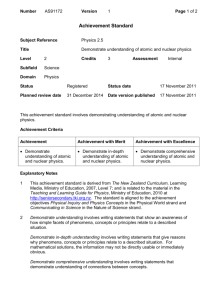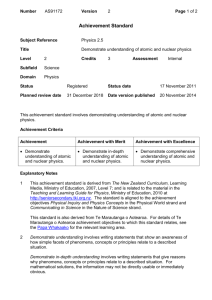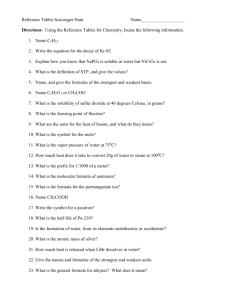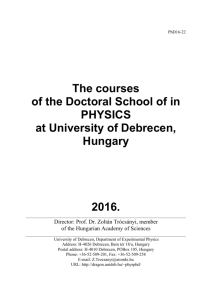PH1_CGE_Unit13Modern_V01
advertisement
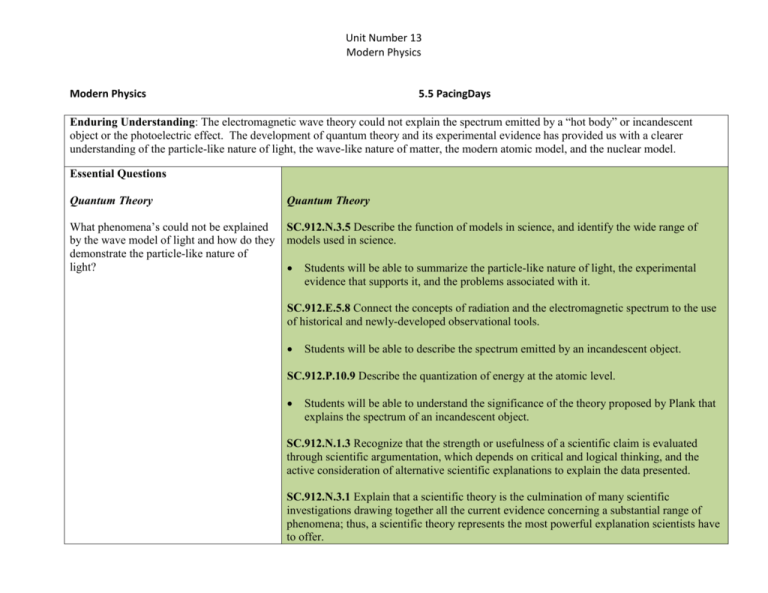
Unit Number 13 Modern Physics Modern Physics 5.5 PacingDays Enduring Understanding: The electromagnetic wave theory could not explain the spectrum emitted by a “hot body” or incandescent object or the photoelectric effect. The development of quantum theory and its experimental evidence has provided us with a clearer understanding of the particle-like nature of light, the wave-like nature of matter, the modern atomic model, and the nuclear model. Essential Questions Quantum Theory Quantum Theory What phenomena’s could not be explained by the wave model of light and how do they demonstrate the particle-like nature of light? SC.912.N.3.5 Describe the function of models in science, and identify the wide range of models used in science. Students will be able to summarize the particle-like nature of light, the experimental evidence that supports it, and the problems associated with it. SC.912.E.5.8 Connect the concepts of radiation and the electromagnetic spectrum to the use of historical and newly-developed observational tools. Students will be able to describe the spectrum emitted by an incandescent object. SC.912.P.10.9 Describe the quantization of energy at the atomic level. Students will be able to understand the significance of the theory proposed by Plank that explains the spectrum of an incandescent object. SC.912.N.1.3 Recognize that the strength or usefulness of a scientific claim is evaluated through scientific argumentation, which depends on critical and logical thinking, and the active consideration of alternative scientific explanations to explain the data presented. SC.912.N.3.1 Explain that a scientific theory is the culmination of many scientific investigations drawing together all the current evidence concerning a substantial range of phenomena; thus, a scientific theory represents the most powerful explanation scientists have to offer. Students will be able to explain how the photoelectric effect and the Compton Effect demonstrate the particle-like nature of light. SC.912.N.3.4 Recognize that theories do not become laws, nor do laws become theories; theories are well supported explanations and laws are well supported descriptions. What evidence is there for the wave-like nature of matter? Students will be able to describe evidence of the wave-like nature of matter. Atomic Theory Atomic Theory How did the early models of the atom lead to the Quantum Model? SC.912.N.1.6 Describe how scientific inferences are drawn from scientific observations and provide examples from the content being studied. SC.912.N.2.4 Explain that scientific knowledge is both durable and robust and open to change. Scientific knowledge can change because it is often examined and re-examined by new investigations and scientific argumentation. Because of these frequent examinations, scientific knowledge becomes stronger, leading to its durability. SC.912.N.2.5 Describe instances in which scientists' varied backgrounds, talents, interests, and goals influence the inferences and thus the explanations that they make about observations of natural phenomena and describe that competing interpretations (explanations) of scientists are a strength of science as they are a source of new, testable ideas that have the potential to add new evidence to support one or another of the explanations. SC.912.P.8.3 Explore the scientific theory of atoms (also known as atomic theory) by describing changes in the atomic model over time and why those changes were necessitated by experimental evidence. Nuclear Physics What led to the current nuclear model and Students will be able to summarize the early models of the atom and their shortcomings. Students will be able to describe the Quantum Model. Nuclear Physics explain how energy produced in nuclear reaction? SC.912.P.8.4 Explore the scientific theory of atoms (also known as atomic theory) by describing the structure of atoms in terms of protons, neutrons and electrons, and differentiate among these particles in terms of their mass, electrical charges and locations within the atom. SC.912.N.4.2 Weigh the merits of alternative strategies for solving a specific societal problem by comparing a number of different costs and benefits, such as human, economic, and environmental. SC.912.P.10.1 Differentiate among the various forms of energy and recognize that they can be transformed from one form to others. SC.912.L.17.11 Evaluate the costs and benefits of renewable and nonrenewable resources, such as water, energy, fossil fuels, wildlife, and forests. SC.912.L.17.15 Discuss the effects of technology on environmental quality. Students will be able to describe the parts of an atomic nucleus and how radioactive decay affects these parts. Students will be able to describe the relationship between mass and energy. 𝐸 = 𝑚𝑐 2 Students will be able to distinguish between fission and fusion. Students will be able to compare fission and fusion reactors and the advantages and disadvantages of each as an alternate energy source. SC.912.P.10.10 Compare the magnitude and range of the four fundamental forces (gravitational, electromagnetic, weak nuclear, strong nuclear). What are the three families of elementary particles and how are the electron, proton, and neutron classified? What are the four fundamental interactions in nature? Research the problems and limitations of the Standard Model of Matter. SC.912.E.5.1 Cite evidence used to develop and verify the scientific theory of the Big Bang (also known as the Big Bang Theory) of the origin of the universe. Students will be able to describe the Standard Model of matter. Students will be able to describe the four fundamental interactions in nature.
